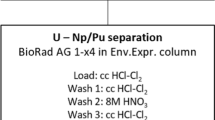Abstract
A large group of radiopharmaceuticals includes complex radionuclide-ligand compounds which are very sensitive to the preparation conditions, as for example pH of reaction mixture, incubation time, temperature, molar ratio of reagents, etc. It is necessary to find the optimum condition for the formation of the radionuclide-ligand complex and to select the convenient analytical methods to determine the purity of the product. The preparation of radiopharmaceuticals labeled by rhenium-186 or rhenium-188 requires the addition of a reducing agent (commonly stannous chloride) to the reaction mixture in order to reduce perrhenate to a lower oxidation state which is capable of complex formation. For rhenium concentration up to approximately 10-5 mol/l, the molar excess of reduction agent over perrhenate is usually higher than 800 to reach the optimum yield of reduction and complexation (between 80-95%). Because of the potentially toxic effect of SnCl2 the reduction of perrhenate by stannous chloride was studied in detail to find the way for decreasing the concentration of reducing agent in the reaction mixture without significant lowering of the yield of perrhenate reduction. The reduction of perrhenate was determined by electromigration methods, i.e., capillary electrophoresis (CZE) and isotachophoresis (ITP), and thin-layer chromatography (TLC) with radiometric detection. The highest degree of reduction of perrhenate was obtained at pH 2 at perrhenate concentration ranging from 10-4 to 10-3 mol/l. The stability of reduced rhenium against a pH change from 2 to 5.5 (which corresponds to the pH close to physiological values) was tested as well. The influence of the presence of ascorbic acid as an antioxidant in the reaction mixture on the stability of the preparation against the pH change was determined. The stability of reduced rhenium against dilution of rhenium in the reaction mixture to the concentration suitable for the application in radiotherapy was also found out. The data acquired by capillary electrophoresis, isotachophoresis and thin-layer chromatography are comparable. Results obtained in these experiments were applied for the study of rhenium complexes with hydroxyethylidenediphosphonic acid (HEDP).
Similar content being viewed by others
References
J. R. Dilworth, S. J. Parrott, Chem. Soc. Rev., 27 (1998) 43.
L. S. Johnson, J. C. Yanch, S. Shortkoff, C. L. Balrnes, A. I. Spityer, C. B. Sledge, Eur. J. Nucl. Med., 22 (1995) 977.
R. Franceschini, M. Chinol, A. Pecorale, G. Deleide, F. F. Knapp Jr., G. Paganelli, Industrial Production of a 188W/188Re Generator and its Validation by Preparing 188Re-MDP Using Carrier Free 188Re. Proc. 2nd National Joint Congress SIRR-GIR, Palermo, September 11-14, 1996.
Q. Liang, G. J. Erhardt, A. R. Ketring, R. Miller, Radiochim. Acta, 79 (1997) 137.
H. Kamioki, S. Mirzadeh, R. M. Lambrecht, F. F. Knapp Jr., K. Dadachova, Radiochim. Acta, 65 (1994) 39.
F. F. Knapp Jr., A. L. Beets, S. Guhlke, P. O. Zamora, H. Bender, H. Palmedo, H.-J. Biersack, Anticanc. Res., 17 (1997) 1783.
K. Horiuchi-Suzuki, Y. Arano, A. Yokoyama, Challenges Associated with Re-186: From Carrier-Free 99mTc(V)-DMS to Carrier Containing 186Re(V)-DMS, Intern. Symp. on Modern Trends in Radiopharmaceuticals for Diagnosis and Therapy, Lisbon, Portugal, March 3-April 3, 1998.
M. KohlÍikovÁ, V. JedinÁkovÁ-KpÍyovÁ, R. KonÍpovÁ, J. Radioanal. Nucl. Chem., 242 (1999) 545.
R. KonÍpovÁ, M. KohlÍikovÁ, V. JedinÁkovÁ-KpÍyovÁ, J. Radioanal. Nucl. Chem., 246 (2000) 589.
K. Hashimoto, S. Bagiawati, M. Izumo, K. Kobayashi, Appl. Radiation Isotopes, 47 (1996) 195.
J. Singh, K. Reghebi, C. R. Lazarus, S. E. M. Clarke, A. P. Callahan, F. F. Knapp Jr., P. J. Blower, Nucl. Med. Commun., 14 (1993) 197.
J. M. H. de Klerk, A. D. van het Schip, B. A. Zonnenberg, A. van Dijk, J. M. S. P. Quirijnen, G. H. Blijham, P. P. van Rijk, J. Nucl. Med., 37 (1996) 244.
H. Wittrisch, S. Conradi, E. Rohde, J. Vogt, C. Vogt, J. Chromatogr., A781 (1997) 407.
R. Jankowski, M. Friebe, B. Noll, B. Johannsen, J. Chromatogr., A833 (1999) 83.
A. Van Schepdael, K. Verbeke, C. Van Nerom, J. Hoogmartens, A. Verbruggen, J. Chromatogr., B697 (1997) 251.
N. K. Triphaty, F. E. Wurgler, H. Frei, Mutat. Res., 242 (1990) 169.
J. C. de Mattos, F. J.DANTAS, R. J. Bezerra, M. BernardoFilho, J. B. Cabral-Neto, C. Lage, A. C. Leitao, A. Caldeira-de-Araujo, Toxicol. Lett., 116 (2000) 159.
M. KohlÍikovÁ, V. JedinÁkovÁ-KpÍyovÁ, J. Radioanal. Nucl. Chem., 246 (2000) 549.
Author information
Authors and Affiliations
Rights and permissions
About this article
Cite this article
Kohlíčková-Koudelková, M., Konířová, R. & Jedináková-Křížová, V. Chromatographic and electromigration analysis of rhenium compounds used in radiopharmacy. Journal of Radioanalytical and Nuclear Chemistry 258, 627–633 (2003). https://doi.org/10.1023/B:JRNC.0000011760.55124.49
Issue Date:
DOI: https://doi.org/10.1023/B:JRNC.0000011760.55124.49




